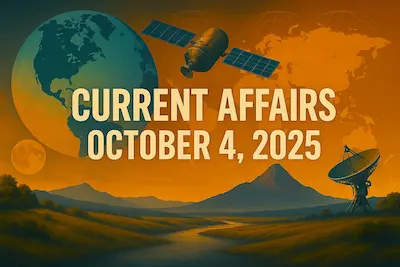1. BRO Project Swastik Marks 65 Years of Service –Defence & Security
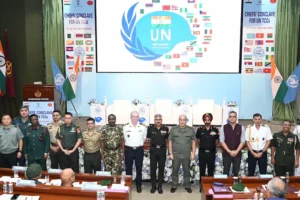
Why in News?
The Border Roads Organisation (BRO) Project Swastik celebrated its 65th Raising Day on October 1, 2025, reaffirming its critical role in strategic infrastructure development in India’s border regions.
About BRO Project Swastik
Established: 1960 as Project DRAGON, renamed Project Swastik on October 1, 1963.
Under: Ministry of Defence.
Mandate: Construction and maintenance of strategic roads, bridges, and tunnels in challenging border areas.
Area of Responsibility
Geographical Focus: North and East Sikkim, parts of North Bengal.
Terrain & Climate: Landslide-prone, high-altitude areas with severe weather conditions.
Strategic Importance
Military Mobility: Ensures rapid deployment and logistics for the Armed Forces.
Disaster Management: Plays a frontline role in restoring connectivity during natural calamities.
Civilian Impact: Improves socio-economic access in remote and border areas.
Major Accomplishments (Till 2025)
Total Roads Constructed: Over 1,412 km.
Major Bridges: 80 constructed.
Recent Decade (last 10 years):
350 km of new roads.
26 major bridges.
1 tunnel.
Key Road Links
Gangtok–Chungthang Road
Gangtok–Nathula Road
Both routes are vital for:Defence logistics
Civilian transportation
Tourism and trade with border regions
Disaster Response
2023 Sikkim Flash Floods: BRO Project Swastik played a key role in restoring roads and bridges, re-establishing critical supply lines and communication.
Exam Connect – Possible Questions
Prelims
1. Consider the following statements about BRO Project Swastik:
1.It was initially called Project DRAGON.
2.It operates primarily in the western Himalayan region.
3.It functions under the Ministry of Road Transport and Highways.
Which of the above statements is/are correct?
A. 1 only
B. 1 and 2 only
C. 2 and 3 only
D. 1, 2, and 3
Answer: A. 1 only
Explanation: Statement 2 is incorrect – it operates in eastern regions (Sikkim & North Bengal). Statement 3 is incorrect – it is under the Ministry of Defence.
2. Which of the following is/are key roles of BRO Project Swastik?
1.Enhancing military mobility in border areas
2.Providing rapid disaster relief infrastructure
3.Operating airfields in high-altitude areas
Select the correct answer using the code below:
A. 1 and 2 only
B. 1 and 3 only
C. 2 and 3 only
D. All of the above
Answer: A. 1 and 2 only
Explanation: BRO does not operate airfields; that is under IAF. Its primary roles are road infrastructure and disaster response.
Mains
1. Discuss the strategic and socio-economic significance of BRO Project Swastik in the context of India’s border infrastructure development.
2. Evaluate the role of BRO in disaster response in high-altitude and remote regions, with special reference to the 2023 Sikkim flash floods.
2. Should Ladakh Get Statehood? – Polity
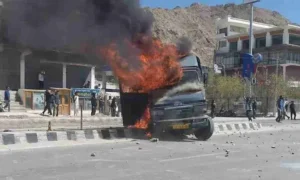
Why in News?
Recent violence in Leh, which led to four deaths and the arrest of climate activist Sonam Wangchuck, has brought renewed attention to growing political discontent in Ladakh. Key local groups like the Leh Apex Body (LAB) and Kargil Democratic Alliance (KDA) are intensifying their demands for:
Full statehood
Inclusion under the Sixth Schedule of the Constitution
Separate Lok Sabha representation
Establishment of a Public Service Commission (PSC)
Background: Ladakh’s Constitutional Status
In August 2019, under the Jammu & Kashmir Reorganisation Act, Ladakh was carved out as a separate Union Territory (UT), without a Legislative Assembly.
Expectations of increased autonomy and development followed—but local aspirations remain unfulfilled.
Key Concerns and Demands
1. Democratic Deficit
Before 2019, Ladakh had representation in the J&K Legislative Assembly.
As a UT without legislature, Ladakhis now lack effective representation in law-making and governance.
2. Bureaucratic Overreach
The administration is dominated by short-term bureaucrats, leading to:
Marginalisation of local elected Hill Councils
Lack of accountability to local communities
3. Tribal and Land Rights Protection
Removal of Article 370 and 35A has raised fears of:
Demographic change
Loss of job and land protections
Ladakh has a majority tribal population, and demands protection under Sixth Schedule to safeguard their cultural and economic rights.
Centre’s Position
The central government acknowledges the Sixth Schedule as a possible solution.
However, it has not committed to statehood.
Concerns over low population (approx. 3 lakh) are cited as a barrier to granting full statehood.
Counterpoint: Sikkim and Goa, with similar population sizes, were granted statehood due to unique political and cultural factors.
Key Constitutional & Federalism Issues
The Ladakh issue highlights deeper challenges in Indian federalism:
Top-down governance in sensitive border regions
Failure to balance national interest with local aspirations
Effective federalism requires decentralization, local participation, and trust-building.
Exam Connect – Possible Questions
Prelims
1. Consider the following statements with respect to the Sixth Schedule of the Indian Constitution:
1.It provides for the administration of tribal areas in Assam, Meghalaya, Tripura, and Mizoram.
2.It allows for the creation of Autonomous District Councils with legislative and judicial powers.
3.Ladakh is currently included under the Sixth Schedule.
Which of the above statements is/are correct?
A. 1 and 2 only
B. 2 and 3 only
C. 1 and 3 only
D. All of the above
Answer: A. 1 and 2 only
Explanation: Statement 3 is incorrect – Ladakh is not currently under the Sixth Schedule.
2. Which of the following is a correct reason cited by the Centre against granting statehood to Ladakh?
A. Lack of natural resources
B. High levels of insurgency
C. Small population size
D. Lack of economic viability
Answer: C. Small population size
Mains
1. Critically examine the demand for statehood for Ladakh in the context of democratic decentralization and constitutional safeguards for tribal regions.
2. Discuss how the current administrative structure of Ladakh challenges the principles of cooperative federalism in India. Suggest measures to ensure inclusive and participatory governance in the region.
3. Centre Approves National Pulses Mission –Economy
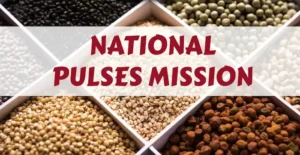
Why in News?
The Union Minister for Agriculture & Farmers’ Welfare has approved the National Pulses Mission, also known as the Mission for Atmanirbharta in Pulses.
The initiative aims to make India self-sufficient in pulses production by 2030–31.
Key Objectives
Target Year: 2030–31
Current Production (2024–25): 24.2 million tonnes (MT)
Target Production: 35 MT by 2030–31
Coverage: 416 districts
Budget Outlay: ₹11,440 crore
Key Features of the Mission
1. Launch & Implementation
Year of Launch: 2025
Operating Framework: Under the National Food Security Mission (NFSM)
Led by ICAR with private sector partnerships for:
R&D in pulse varieties
Processing, storage, and logistics solutions
2. MSP Procurement Guarantee
100% assured MSP for Tur, Urad, and Masoor pulses
Backed by the PM-AASHA Price Support Scheme
Procurement through NAFED and NCCF
Guarantee available for four years to provide price stability
3. Cluster-Based Strategy
Focus on high-potential agro-climatic zones
Encourages regional crop diversification and risk mitigation
4. Post-Harvest Infrastructure
Plan to set up 1,000 dal mills/post-harvest units
Subsidy up to ₹25 lakh per unit to encourage processing at source
5. Research & Extension Services
Climate-resilient, high-yield varieties of pulses
Farmer training on:
Nutrient management
Pest control
Efficient irrigation techniques
6. Risk Management & Financial Support
Insurance coverage and cultivation risk subsidies
Easier credit access for small and marginal farmers
7. Market Linkages & Reforms
Promotion of direct-to-consumer models
Transparent logistics and storage systems
Improved price discovery and real-time data for farmers
Expected Outcomes
Food and Nutritional Security: Pulses are rich in protein and key micronutrients.
Soil Health Improvement: Pulses enrich the soil with nitrogen through biological fixation.
Price Stability: MSP-backed procurement will stabilize market volatility.
Climate Resilience: Short-duration pulse crops can withstand erratic weather.
Employment Generation: Post-harvest infrastructure will create rural livelihood opportunities.
Exam Connect – Possible Questions
Prelims
1. The National Pulses Mission aims to achieve self-sufficiency in pulse production by:
A. 2025
B. 2027
C. 2030–31
D. 2035
Answer: C. 2030–31
2. Which of the following features are part of the National Pulses Mission?
1.Cluster-based approach
2.MSP-backed procurement for Tur, Urad, and Masoor
3.Operation under the National Food Security Act
4.Post-harvest infrastructure with capital subsidies
Select the correct option:
A. 1, 2, and 4 only
B. 1, 3, and 4 only
C. 2, 3, and 4 only
D. All of the above
Answer: A. 1, 2, and 4 only
Explanation: The mission operates under National Food Security Mission, not the NFSA.
Mains
1.Discuss the role of the National Pulses Mission in achieving agricultural self-reliance in India. How does it address the twin goals of food security and climate resilience?
2.Evaluate the effectiveness of MSP-backed procurement schemes like PM-AASHA in stabilizing farmer incomes and promoting pulse cultivation in India.
4. What Are Flying Rivers / Atmospheric Rivers? –Geography
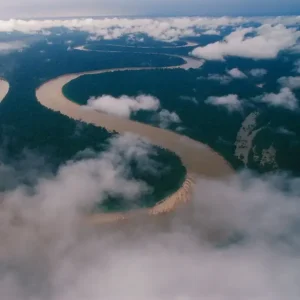
Why in News?
Recent droughts and wildfires in South America, especially in regions around the Amazon, have drawn attention to the critical role of “flying rivers”, also known as atmospheric rivers (ARs).
These vapor-rich streams are being disrupted due to deforestation, with major implications for regional and global weather systems.
What Are Atmospheric Rivers (ARs)?
Definition: Long, narrow bands of concentrated water vapor in the lower atmosphere, often called “rivers in the sky.”
Also Known As: Flying Rivers – particularly in the Amazon context, where forests contribute moisture to these systems.
Key Characteristics
| Parameter | Value / Description |
|---|---|
| Length | 2,000–5,000 km |
| Width | 400–500 km |
| Depth | ~3 km (lower troposphere) |
| Water Capacity | Can carry as much water vapor as 2x the Amazon River’s flow |
Formation Process
1. Evaporation from warm tropical oceans.
2. Winds transport water vapor in narrow corridors across continents.
3. When this moist air hits land or mountain ranges, it condenses—producing heavy rainfall or snow.
Global Significance
Positive Impacts
US West Coast: Provide 30–50% of annual rainfall; help end droughts.
East Asia: Up to 80% of early monsoon rainfall in China, Japan, Korea comes from ARs.
Negative Impacts
Extreme Weather Events:
Responsible for 80% of flood-related damages on the US West Coast.
Linked to floods across Europe, Africa, South America, Australia.
Amazon Disruption:
Deforestation disrupts moisture recycling.
Leads to droughts in Peru, Bolivia, Ecuador, and worsens the Amazon’s climate resilience.
Climate Change Impact:
Warmer oceans = stronger, longer ARs
Increases risk of flash floods, landslides, and crop failures
Atmospheric Rivers in the Indian Context
AR–Monsoon Interaction
ARs interact with:
Monsoonal winds
Cyclonic circulations
Himalayan ranges
Result: Intense rainfall events, flash floods, and landslides
Key Case Studies
2010 Leh Cloudburst (Ladakh): Flash floods and mudslides from AR activity.
2011 Kupwara Floods (J&K): Result of high-intensity AR-driven precipitation.
Recent Findings (1951–2020)
574 AR events recorded during Indian monsoons.
80% of India’s severe floods (1985–2020) linked to ARs.
Emerging Trends
Rapid Indian Ocean warming increases:
Evaporation
Moisture transport
AR intensity
Consequences:
Short, intense rainfall bursts
Crop loss
Displacement of rural communities
Exam Connect – Possible Questions
Prelims
1. Atmospheric rivers, recently in the news, are:
A. High-speed winds formed in the stratosphere
B. Narrow corridors of concentrated water vapor in the atmosphere
C. Subsurface oceanic currents
D. Artificial irrigation channels for desert regions
Answer: B. Narrow corridors of concentrated water vapor in the atmosphere
2. Which of the following statements is/are correct?
1.Atmospheric rivers are typically found only in tropical regions.
2.They are responsible for both heavy rainfall and drought mitigation.
3.The Amazon rainforest plays a role in sustaining atmospheric rivers.
Select the correct option:
A. 1 and 2 only
B. 2 and 3 only
C. 1 and 3 only
D. All of the above
Answer: B. 2 and 3 only
Explanation: Statement 1 is incorrect – ARs occur in mid-latitudes and subtropics, not only tropical regions.
Mains
1.What are atmospheric rivers? Discuss their role in shaping regional weather patterns and their growing relevance in the context of climate change.
2. Examine the link between deforestation in the Amazon and the disruption of atmospheric rivers. What lessons can India draw to safeguard its monsoon systems?
5. Draft Rules for Regulation of Online Gaming in India – Polity
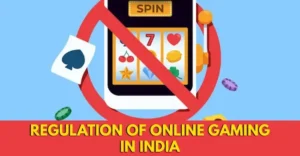
Why in News?
The Ministry of Electronics and Information Technology (MeitY) has released draft rules under the newly enacted Promotion and Regulation of Online Gaming Act, 2025, which received Presidential assent in August 2025.
The aim is to regulate online gaming, ensure user safety, promote responsible gaming, and tackle issues related to addiction, fraud, and financial exploitation.
Background: Why Regulation Was Needed
Rapid growth of the online gaming sector (mobile gaming, fantasy sports, e-sports)
Rising concerns over:
Gaming addiction, especially among youth
Monetary losses, debt, and online scams
Gambling disguised as gaming
Lack of data protection and user safeguards
Regulatory confusion due to inter-state legal variations on betting and gaming
Key Provisions of the Draft Rules (2025)
1. Definition of Online Gaming
Covers games played on any digital platform (mobile, desktop, console) with monetary stakes or real-time interaction
Excludes offline and non-monetary games
2. Mandatory Self-Regulatory Bodies (SRBs)
Gaming companies must be registered with MeitY-approved SRBs
SRBs will:
Vet games for compliance
Enforce fair play and safe design
Maintain grievance redressal mechanisms
3. User Verification & Protection
Mandatory KYC (Know Your Customer) norms for all users
Age verification to prevent underage gaming
Limit on daily and monthly expenditure for users
4. Prohibited Content
Games promoting:
Violence, extreme addiction
Sexual content, or
Real-money betting
without regulatory approval, will be banned
5. Transparency in Game Design
Disclosure of:
Reward mechanisms
Winning probabilities
Use of algorithms
6. Advertising Guidelines
Ban on misleading ads claiming guaranteed earnings
Warnings for financial risks must be prominently displayed
7. Penalty Provisions
Heavy financial penalties and de-platforming for violations
Penal action against companies not complying with KYC, grievance redress, or content norms
Significance of the Draft Rules
First national-level regulation for online gaming in India
Balances innovation and investment in the gaming sector with consumer protection
Closes legal loopholes exploited by gambling platforms
Encourages a structured and ethical gaming ecosystem
Concerns & Challenges
Possible over-regulation could stifle innovation/startups
Ambiguity in distinction between skill-based games and games of chance
Enforcement difficulty across state jurisdictions
Need for clear data privacy safeguards
International Practices
UK: Gambling Commission regulates online games with monetary transactions
South Korea: Strict age verification and gaming time limits
China: Government caps on playtime for minors to prevent addiction
Way Forward
Stakeholder consultations to refine the final rules
Strong data protection framework integration
Clear classification between legal skill-based games and illegal betting
Regular monitoring by an independent gaming authority
Exam Connect – Possible Questions
Prelims
1. Consider the following statements about the Promotion and Regulation of Online Gaming Act, 2025:
1.It is administered by the Ministry of Youth Affairs and Sports.
2.It mandates KYC verification for users of online gaming platforms.
3.It excludes non-monetary games from its ambit.
Which of the above statements is/are correct?
A. 1 and 2 only
B. 2 and 3 only
C. 1 and 3 only
D. All of the above
Answer: B. 2 and 3 only
Explanation: It is administered by MeitY, not the Ministry of Youth Affairs.
2. Which of the following is not a feature of the draft rules for online gaming regulation in India (2025)?
A. Age verification and expenditure limits
B. Guaranteed earnings for users
C. Registration with self-regulatory bodies
D. Mandatory user KYC
Answer: B. Guaranteed earnings for users
Explanation: Misleading claims of guaranteed earnings are explicitly banned.
Mains
1.Discuss the need for national regulation of online gaming in India. How do the 2025 draft rules attempt to balance innovation with user protection?
2.Examine the constitutional and legal challenges involved in regulating online gaming in India, especially in the context of federalism and state subject lists.
6. Cost of Convenience: Health Hazards and Environmental Threats from E-Waste – Environment
Why in News?
India’s rapid digital transformation has resulted in an unprecedented rise in electronic waste (e-waste).
In 2025, India generated 2.2 million tonnes of e-waste — becoming the third-largest e-waste producer globally, after China and the USA.
Despite having formal recycling capacity, most e-waste is handled informally, leading to serious environmental degradation and public health risks.
Key Highlights
E-Waste Generation:
2.2 million tonnes (2025)
150% increase since 2017–18
Projected to double by 2030
Urban E-Waste Hotspots:
Seelampur (Delhi)
Moradabad (Uttar Pradesh)
Bhiwandi (Maharashtra)
These areas are hubs for informal dismantling and recycling operations.
Source Concentration:
Over 60% of e-waste comes from just 65 cities
E-Waste Recycling in India
Informal Recycling Methods
Manual dismantling without protective equipment
Open-air burning of plastic components
Acid-leaching of circuit boards
Practices often involve children and untrained workers
Toxic Chemical Exposure
Over 1,000 hazardous chemicals released
Includes:
Heavy metals: Lead, mercury, cadmium
Persistent Organic Pollutants (POPs): Dioxins, furans
Flame retardants, lithium-ion fumes
Health Hazards
Respiratory Diseases: Asthma, chronic bronchitis
Neurological damage: Memory loss, impaired cognition
Skin and eye irritation, kidney dysfunction
Children and women in informal recycling face the highest risk
Environmental Impact
Air Pollution:
PM2.5 levels > 300 µg/m³ in recycling zones
WHO safe limit: 25 µg/m³
Air quality is 12x worse than international safety norms
Soil and Water Contamination:
Heavy metal leaching into soil and groundwater
Bioaccumulation in local flora/fauna disrupts food chains and biodiversity
Policy and Legal Framework
| Instrument | Description |
|---|---|
| E-Waste (Management) Rules, 2022 | Mandates Extended Producer Responsibility (EPR) |
| CPCB Monitoring | Central Pollution Control Board oversees compliance |
| Digital India Initiatives | Promote electronics penetration, but risk unmanaged waste |
| Eco-Mark Certification | Incentivizes eco-friendly electronics |
Challenge: Enforcement is weak. Informal sector remains unintegrated and unregulated
Way Forward
1. Formalize the Informal Sector
Skill training, protective gear, and recognition for informal workers
Integrate them into authorized recycling units
2. Strengthen Enforcement
Crackdown on illegal recycling clusters
Strengthen CPCB and SPCB inspection mechanisms
3. Producer Responsibility
Strict implementation of EPR norms
Penal action for non-compliant manufacturers
4. Citizen Awareness
Campaigns for safe disposal and e-waste collection drives
5. Eco-Innovation
Incentivize modular design, repairable products, and eco-labeling
Exam Connect – Possible Questions
Prelims
1. Which of the following chemicals are commonly associated with informal e-waste recycling?
1.Lead
2.Mercury
3.Sulphur dioxide
4.Persistent Organic Pollutants (POPs)
Select the correct answer:
A. 1, 2, and 4 only
B. 1 and 3 only
C. 2 and 3 only
D. All of the above
Answer: A. 1, 2, and 4 only
Explanation: SO₂ is linked to fossil fuel combustion, not e-waste directly.
2. Which of the following Indian cities is not commonly identified as a major e-waste processing hotspot?
A. Seelampur
B. Moradabad
C. Surat
D. Bhiwandi
Answer: C. Surat
Mains
1.Discuss the major environmental and health hazards posed by e-waste in India. How can policy measures address the challenges posed by the informal recycling sector?2.
With reference to India’s digital growth, evaluate the role of Extended Producer Responsibility (EPR) in ensuring sustainable e-waste management.

